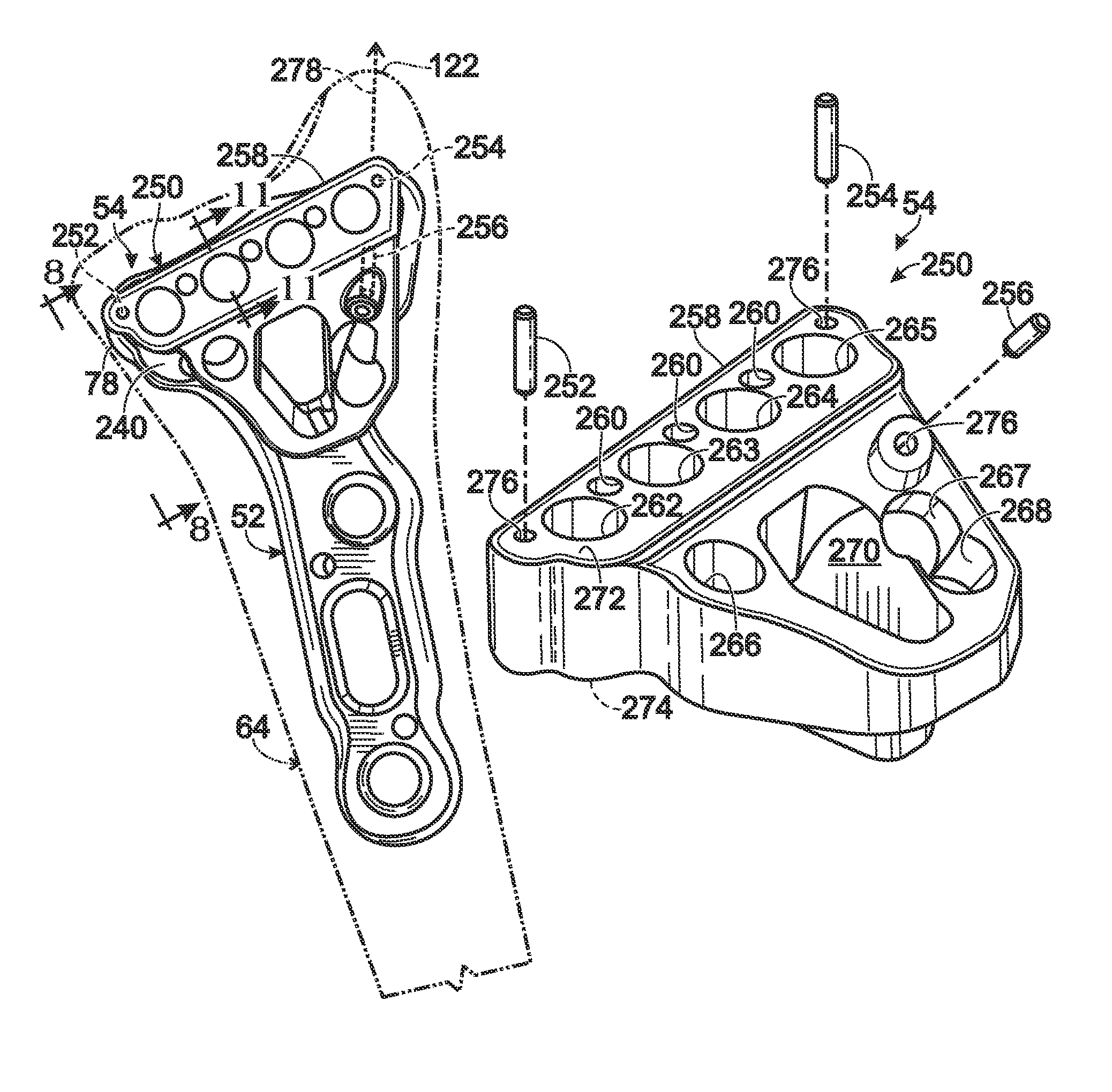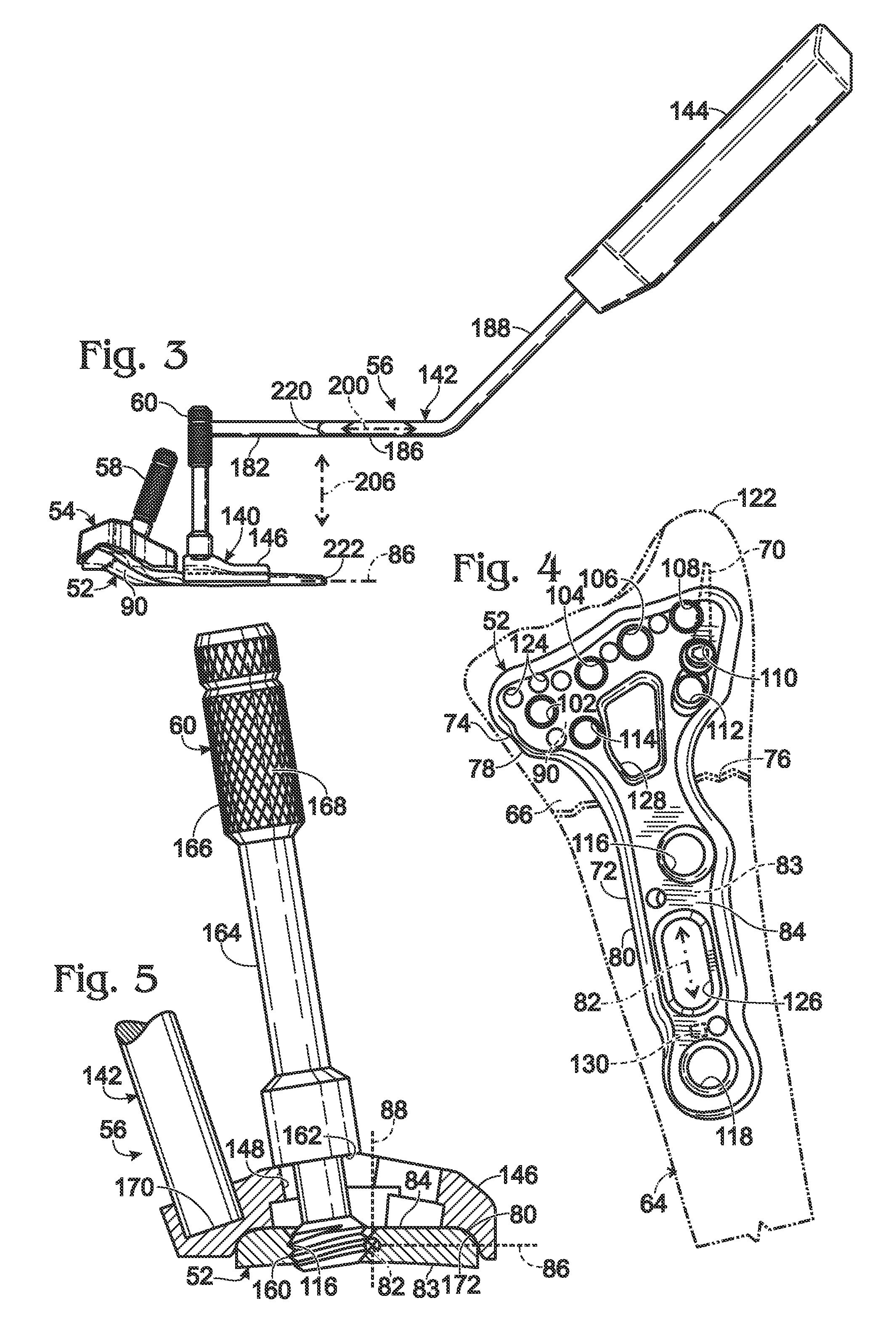Targeting guide with a radiopaque marker to facilitate positioning a bone plate on bone
a radiopaque marker and target guide technology, applied in bone drill guides, medical science, surgery, etc., can solve the problems of affecting the plate is susceptible to a variety of fractures and deformities, and the radioidal column is easy to shift, so as to facilitate the positioning of the bone pla
- Summary
- Abstract
- Description
- Claims
- Application Information
AI Technical Summary
Benefits of technology
Problems solved by technology
Method used
Image
Examples
example 1
Exemplary Radiographic Images
[0096]This example describes exemplary radiographic images that may be generated with an exemplary bone fixation system disposed on an exemplary bone; see FIGS. 12-14.
[0097]Relative radiopacity is indicated in the images by shading, with bone 64 being less radiopaque than bone plate 52, which in turn is less radiopaque than markers 252-256 and extension portion 142 of handle 56. Structures that block X-rays most efficiently are darkest in the images, and would be lightest in negative versions of the images.
[0098]FIG. 12 shows an exemplary radiographic image 320 of bone fixation system 50 and radial bone 64 (see FIG. 1). Fasteners 58, 60 are not shown to simplify the presentation. Image 320 may be generated using a radiation beam having a beam axis that is orthogonal to a plane defined by bone plate 52, and is directly along an anterior-posterior through the bone. A surgeon can find the proper beam axis for the image shown by adjusting the beam axis until...
example 2
Selected Embodiments I
[0101]This example describes selected embodiments of the present disclosure involving a handle, presented as a series of indexed paragraphs.
[0102]1. A method of situating a bone plate on bone, comprising: (A) connecting a targeting guide and a handle to a bone plate to form an assembly; (B) detecting one or more radiographic images of the assembly with the assembly disposed on a surface region of a bone; and (C) positioning the assembly on the surface region based on a pair of nonparallel axes defined in the images by the targeting guide and the handle.
[0103]2. The method of paragraph 1, wherein the step of positioning the assembly is based on first and second axes arranged obliquely to each other.
[0104]3. The method of paragraph 2, wherein the first axis is defined by a relatively radiopaque pin attached to and disposed in a relatively radiolucent body of the targeting guide
[0105]4. The method of paragraph 2, wherein the first axis is configured to extend near...
example 3
Selected Embodiments II
[0152]This example describes selected embodiments of the present disclosure involving a targeting guide in the form of a guide block, presented as a series of indexed paragraphs.
[0153]1. A method of bone fixation, comprising: (A) selecting a bone plate including an outer surface region and defining a plurality of apertures; (B) selecting a guide block defining a plurality of openings and including a radiolucent body and at least one elongated, radiopaque marker disposed in and affixed to the radiolucent body; (C) attaching the guide block to the bone plate with the guide block over the outer surface region of the bone plate and such that openings of the guide block are adjacent to and in coaxial alignment with apertures of the bone plate, wherein attached is performed after the at least one marker is affixed to the radiolucent body; (D) disposing the bone plate on bone; (E) securing the bone plate to the bone with fasteners placed in one or more of the apertur...
PUM
 Login to View More
Login to View More Abstract
Description
Claims
Application Information
 Login to View More
Login to View More - R&D
- Intellectual Property
- Life Sciences
- Materials
- Tech Scout
- Unparalleled Data Quality
- Higher Quality Content
- 60% Fewer Hallucinations
Browse by: Latest US Patents, China's latest patents, Technical Efficacy Thesaurus, Application Domain, Technology Topic, Popular Technical Reports.
© 2025 PatSnap. All rights reserved.Legal|Privacy policy|Modern Slavery Act Transparency Statement|Sitemap|About US| Contact US: help@patsnap.com



